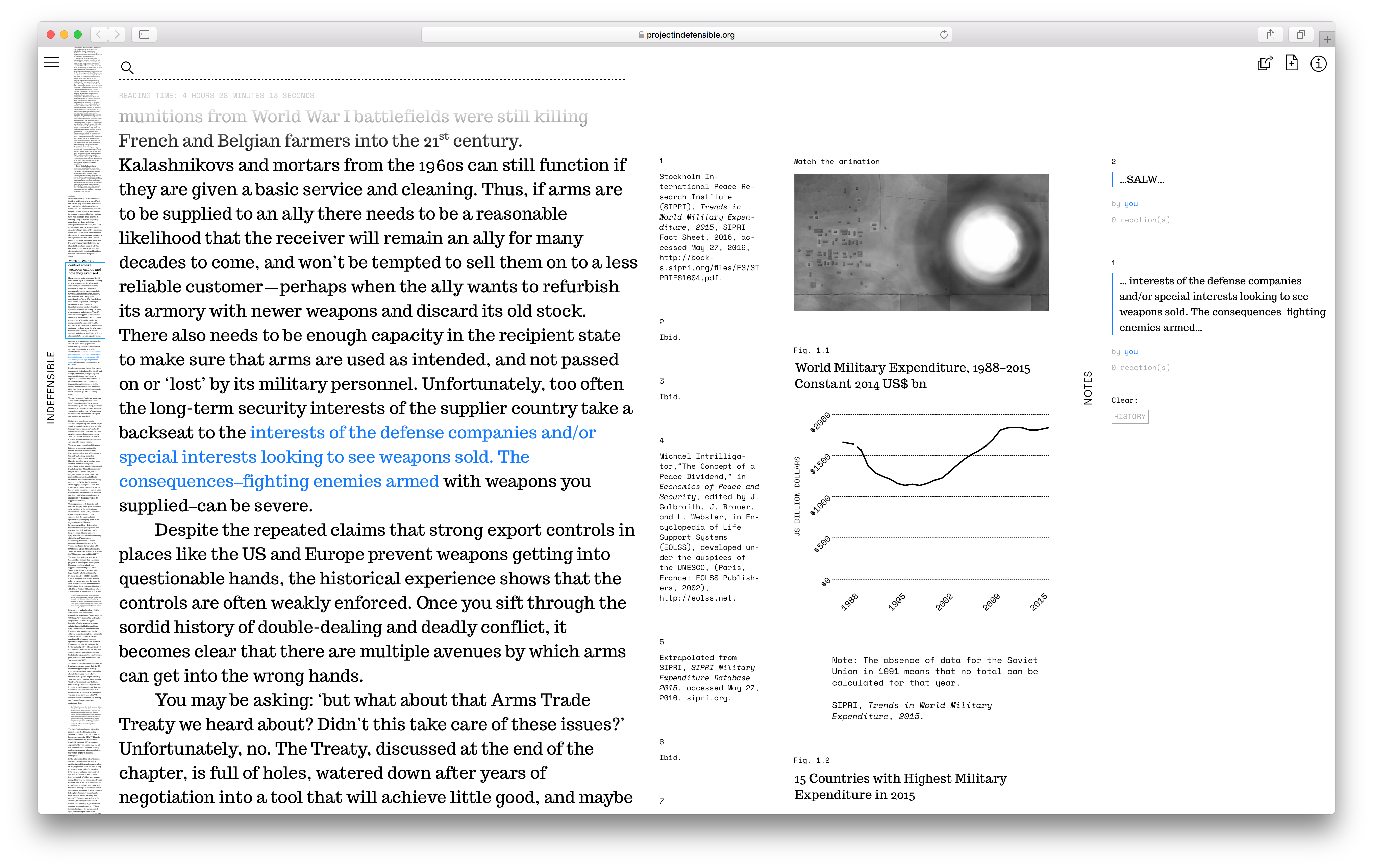Project Indefensible emerged out of a series of research and discussion workshops sponsored by the World Peace Foundation with leading experts on the global arms business. Together, the group defined a goal for their collaboration of fostering an evidence-driven, accountable, and transparent approach to public discussions of the global arms business. The end result of this collaboration is the text of Indefensible.
In order to stimulate this conversation, LUST approached the design and implementation of the website as a critical tool for collaborative reading and writing—offering speculations on scalable reading experiences between all target audiences, situations, and locations centered on the thematics of the Indefensible text.
LUST has always been interested in interpretive practices associated with reader/text relations, often borrowing methodologies from the discipline of literary anthropology. In literary anthropological research, the relationship to a literary text can become an interesting point for the continued interpretation of culture and the way culture is weighted. Each time a previously annotated ‘narrative’ is re-visited, or marked, the context of the last reading changes, therefore affecting the current reading as well. Using similar recursive methodologies, a codex of data (or millions of points of entry) that supports multiple research questions and interests can be developed.
I worked with WPF to create several concepts and sketches for novel ways of approaching the text. As a result, the website for Indefensible offers the reader the following tools to facilitate this discourse:
-
Contextual Search Contextual search provides the reader with an ability to generate an alternate compilation of a text from their own search terms. The occurrence of these terms is reflected in the n-gram; a graph that visualizes their frequency within flow of the original text. This re-interpretation creates an new narrative structure and approach to literary reading. Endless interpretations are possible, sourcing from the reader’s own interests within the text. This opens discussion on audience-generated interpretation and linearity in media as a critical media-making tool.
-
Focus Mode Focus mode provides a method of engaging with literary media under time constraints. While skimming through a piece by scrolling quickly, the key passages become apparent to the reader in contrast to the remainder of the text. This allows readers to engage with core passages without them being decontextualized, as with the traditional pull quote. These sections are integrated within the text non-hierarchically to activate only in situations where a reader is scrolling quickly. Focus mode is an experiment in forms of reading that reflect the audience’s behavior.
-
Annotations The creation of reader annotations is generative of a parallel narrative to the original text. The audience is invited to engage with the content by taking notes and reacting alongside the original. As their own set of annotations is compiled, the annotations take on their own form as a piece of literary media. As the original text and annotations exist laterally, they come together to produce an new and anthropologically-rich reading.
-
Session Sharing Each unique session of annotations produces a sharable link, where the reader can invite others to collaborate in session of annotating. This way of reading, note-taking, and reflection is a facilitator critical engagement and discussion. These sessions invite multiple narratives to exist in dialogue with text, generating multiple readings of the literature.
-
Social Sharing Social sharing allows one to share their session or portions of the reading onto social media. This launches a re-contextualization of the text onto new platforms of community phenomena to result in discourse and meaning-making within larger cultural spheres.
-
Visual Index The visual index is a miniaturization of the text, providing an overview of the text for navigational purposes. This is an immaterial method of way-finding within long texts—analogous to the pages in a printed book. As an index to the content, it gives context for the content readers interact with, as well as a means to reinterpretation of reading through navigation.
- Project Indefensible
- Tufts WPF Discussion

Main View

Highlighting and Note Taking

